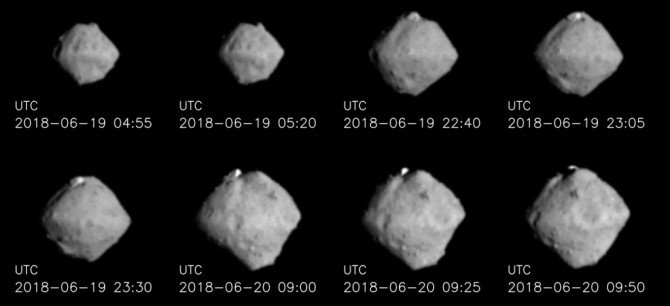
March 9, 2023
Research Highlight
Results from Ryugu

Asteroid Ryugu images by the ONC-T camera onboard Hayabusa2 between June 18 – 20, 2018.Image credit: JAXA, University of Tokyo, Kochi University, Rikkyo University, Nagoya University, Chiba Institute of Technology, Meiji University, University of Aizu and AIST.
In December of 2020, the Hayabusa2 mission delivered samples from the asteroid Ryugu to Earth. Now, the first results from studies of those samples are being published in a series of scientific papers.
Hayabusa2 was launched by the Institute of Space and Astronautical Science of the Japan Aerospace Exploration Agency (JAXA) in 2014 and arrived at Ryugu in June of 2018. Over the course of 18 months, the spacecraft delivered rovers, landers, and a penetrator to the asteroid. In November of 2019, Hayabusa2 departed Ryugu and returned its cache of material to Earth. Now the spacecraft is on an extended mission to visit the asteroid 1998 KY26.

The first sample of asteroid Ryugu received by NASA.Image credit: NASA.
In November of 2021, JAXA delivered samples of the asteroid Ryugu to NASA. Researchers supported by NASA have been working in collaboration with scientists from Japan and other locations around the world to study the material and uncover fascinating details about the early Solar System.
In the new series of publications, experiments have shown that the material from Ryugu contains thousands of different carbon-based molecules (organic molecules). Among these molecules are amino acids and aromatic hydrocarbons. Other minerals found in the asteroid indicate that they formed in the presence of water.
The composition of Ryugu is similar to other carbon-based meteorites that have been found on Earth. What is unique about the Ryugu samples is that they haven’t been altered by heat as they made their way through the atmosphere of Earth, or by chemical, biological, or physical processes at the Earth’s surface.
Samples from Ryugu are pristine pieces of material that formed in the earliest days of the Solar System. These samples can teach us about how our system formed, and how it evolved to support our habitable planet, the Earth.
For more about the findings from Hayabusa2, a post from Many Worlds is available here.
Related:
Hayabusa2 (NASA)
First Look at Ryugu Asteroid Sample Reveals it is Organic-Rich (NASA)
Surprising Insights Into the Asteroid Bennu’s Past, as OSIRIS-REx Prepares For a Sample-Collecting “Tag”
The Many Worlds Blog chronicles the search for evidence of life beyond Earth written by author/journalist Marc Kaufman. The “Many Worlds” column is supported by the Lunar Planetary Institute/USRA and informed by NASA’s NExSS initiative, a research coordination network supported by the NASA Astrobiology Program. Any opinions expressed are the author’s alone.